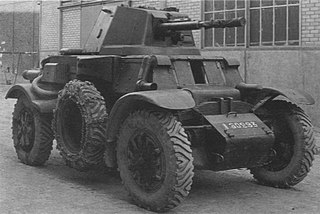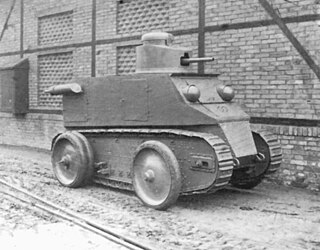
The Panzer II is the common name used for a family of German tanks used in World War II. The official German designation was Panzerkampfwagen II.

The Panzerkampfwagen III, commonly known as the Panzer III, was a medium tank developed in the 1930s by Germany, and was used extensively in World War II. The official German ordnance designation was Sd.Kfz. 141. It was intended to fight other armoured fighting vehicles and serve alongside and support the similar Panzer IV, which was originally designed for infantry support. However, as the Germans faced the formidable T-34, more powerful anti-tank guns were needed, and since the Panzer IV had more development potential with a larger turret ring, it was redesigned to mount the long-barrelled 7.5 cm KwK 40 gun. The Panzer III effectively swapped roles with the Panzer IV, as from 1942 the last version of Panzer III mounted the 7.5 cm KwK 37 L/24 that was better suited for infantry support. Production of the Panzer III ceased in 1943. Nevertheless, the Panzer III's capable chassis provided hulls for the Sturmgeschütz III assault gun until the end of the war.

The FV4201 Chieftain was the main battle tank of the United Kingdom during the 1960s, 1970s and 1980s.

The Panhard ERC is a French six-wheeled armoured car which is highly mobile and amphibious with an option of being NBC-proof. While various models were tested, only two versions of the ERC entered production in large numbers: the ERC-90 Lynx and the ERC-90 Sagaie. The main difference between the two versions is the type of turret and 90 mm gun fitted. Sagaie is French for assegai, a type of African spear.

The Entwicklung series, more commonly known as the E-Series, was a late-World War II attempt by Nazi Germany to produce a standardised series of tank designs. There were to be standard designs in five different weight classes from which several specialised variants were to be developed. This intended to reverse the trend of extremely complex tank designs that had resulted in poor production rates and mechanical unreliability.

The T95 was an American prototype medium tank developed from 1955 to 1959. These tanks used many advanced or unusual features, such as siliceous-cored armor, a new transmission, and the OPTAR fire-control system. The OPTAR incorporated an electro-optical rangefinder and was mounted on the right side of the turret, and was used in conjunction with the APFSDS-firing 90 mm T208 smoothbore gun, which had a rigid mount without a recoil system. In addition, although the tanks were designed with a torsion beam suspension, a hydropneumatic suspension was fitted, and one of the tanks was fitted with a Solar Saturn gas turbine for demonstration purposes.

The SOMUA S35 was a French Cavalry tank of the Second World War. Built from 1936 until 1940 to equip the armoured divisions of the Cavalry, it was for its time a relatively agile medium-weight tank, superior in armour and armament to its French and foreign competitors, such as the contemporary versions of the German Panzerkampfwagen III. It was constructed from well-sloped, mainly cast, armour sections, that however made it expensive to produce and time-consuming to maintain.
The Vextra was a French armored vehicle classified as an armored reconnaissance vehicle, infantry fighting vehicle, fire support vehicle, and/or anti-tank vehicle. It is manned by a four person crew consisting of a commander, a driver, a gunner, and a loader. It was developed in the early 1990s by GIAT industries, now Nexter Systems, and was revealed in 1997.

The ARL 44 was a French heavy tank, the development of which started just before the end of the Second World War. Only sixty of these tanks were ever completed, from 1949 onwards. The type proved to be unsatisfactory and was phased out in 1953.
The Char G1 was a French replacement project for the Char D2 medium tank. Several prototypes from different companies were developed since 1936, but not a single one had been fully completed at the time of the Fall of France in 1940. The projects represented some of the most advanced French tank design of the period and finally envisaged a type that would have been roughly equal in armament and mobility to later World War II standard tanks of other nations, such as the Soviet T-34 and the American M4 Sherman, but possessing several novel features, such as gun stabilisation, a semi-automatic loader and an optical rangefinder.

The Type 95 Heavy Tank was the final result of Japanese multi-turreted tank design, and was in commission during the time period between World War I and World War II. Modeled on German and Italian tank designs, this tank featured 3 turrets. The main armament being a 70 mm cannon in a central turret, with its secondary front turret mounting a 37 mm gun and a 6.5 mm machine gun in the rear turret. Four prototypes were produced in 1934.

The Panhard EBR is an armoured car designed by Panhard for the French Army and later used across the globe, notably by the French Army during the Algerian War and the Portuguese Army during the Portuguese Colonial War in Angola, Mozambique and Guinea-Bissau.

The AMX-40 was a French prototype main battle tank developed by GIAT during the latter stages of the Cold War as an export tank to replace the failed AMX-32. Designed to be an inexpensive tank orientated towards militaries with smaller defence budgets, the AMX-40 featured a lightly armoured hull and good mobility reminiscent of previous French MBTs with a powerful 120 mm cannon. It however failed to attract interest and sales, rendering the project a failure, being discontinued in 1990.

The AMX 50 or AMX-50 was a French heavy tank designed in the immediate post Second World War period. It was proposed as, in succession, the French medium, heavy, and main battle tank, incorporating many advanced features. It was cancelled in the late 1950s however, due to unfavourable economic and political circumstances after serious delays in development.

The OF-40 is an Italian main battle tank developed as a joint venture between OTO Melara and Fiat, and intended primarily for export sales. OTO Melara would develop and produce the hulls, and automotive components would be provided by Fiat. Initial design work was started by OTO Melara in 1977, with the first prototypes ready by 1980.

Emil, also known as the Kranvagn, KRV or Emil Olsson was a tank developed secretly in Sweden during the early 1950s, Kranvagn, meaning mobile crane was a cover-name. The intention was to replace the Swedish Army's disparate tank fleet with a tank that could counter the Soviet IS series heavy tanks and be upgraded continuously. The initial design, in 1951, proposed mounting a 10.5 cm autoloader in an oscillating turret. Due to its size, weight and power to weight it was considered by many to be more of a medium tank than a heavy tank.
The AMX 38 was a prototype French tank designed in 1937 at the AMX works. Designed as AMX's response to the 20-tonne tank programme intended to replace the aging Char D2, it was a faster and heavier alternative to Renault R35, in practice a cross-over between a light tank and medium tank.

The Gendron Somua AMR 39 was a prototype French armoured car.
The Panhard AM 40 P, also known as Model 201, was a prototype French armoured car.

Kolohousenka was a series of Czechoslovakian wheeled and tracked light tanks developed by Skoda, ČKD and Tatra.


















